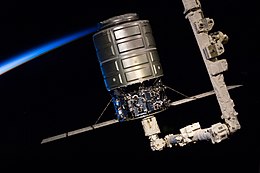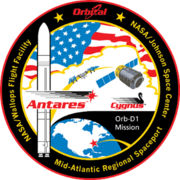
Back Cygnus Orb-D1 Catalan Cygnus Orb-D1 Czech Cygnus Orb-D1 Spanish Cygnus Orb-D1 ID シグナス Orb-D1 Japanese Orb-D1 Latvian/Lettish Cygnus Orb-D1 Polish Cygnus Orb-D1 Russian Cygnus Orb-D1 Slovak Cygnus Orb-D1 Swedish
 Canadarm2 grapples the S.S. G. David Low | |
| Mission type | |
|---|---|
| Operator | Orbital Sciences Corporation |
| COSPAR ID | 2013-051A |
| SATCAT no. | 39258 |
| Mission duration | 35 days, 3 hours, 17 minutes |
| Spacecraft properties | |
| Spacecraft | S.S. G. David Low |
| Spacecraft type | Standard Cygnus[1] |
| Manufacturer |
|
| Launch mass | 4,127 kg (9,098 lb)[2] |
| Payload mass | 700 kg (1,500 lb)[3] |
| Start of mission | |
| Launch date | 18 September 2013, 14:58:02 UTC (10:58:02 am EDT)[4] |
| Rocket | Antares 110[1] |
| Launch site | MARS, Pad 0A |
| End of mission | |
| Disposal | Deorbited |
| Decay date | 23 October 2013, 18:16 UTC |
| Orbital parameters | |
| Reference system | Geocentric orbit[5] |
| Regime | Low Earth orbit |
| Inclination | 51.65° |
| Berthing at ISS | |
| Berthing port | Harmony nadir |
| RMS capture | 29 September 2013, 11:00 UTC |
| Berthing date | 29 September 2013, 12:44 UTC |
| Unberthing date | 22 October 2013, 10:04 UTC |
| RMS release | 22 October 2013, 11:31 UTC |
| Time berthed | 22 days, 21 hours, 20 minutes |
 Orbital mission patch | |
Orbital-D1,[6] also known as Orb-D1,[7][8] and Cygnus 1,[9] was the first flight of the Cygnus cargo spacecraft developed by Orbital Sciences Corporation. It was named after the late NASA astronaut and Orbital Sciences executive G. David Low. The flight was carried out by Orbital Sciences under contract to NASA as Cygnus' demonstration mission in the Commercial Orbital Transportation Services (COTS) program. The mission launched on 18 September 2013 at 14:58:02 UTC. Cygnus was the seventh type of spacecraft to visit the International Space Station (ISS), after the crewed Soyuz and Space Shuttle, and uncrewed Progress, ATV, HTV and Dragon 1.
- ^ a b Cite error: The named reference
Chriswas invoked but never defined (see the help page). - ^ Cite error: The named reference
Gunterwas invoked but never defined (see the help page). - ^ Cite error: The named reference
sfnow20130914was invoked but never defined (see the help page). - ^ Cite error: The named reference
sf101was invoked but never defined (see the help page). - ^ "CYGNUS". N2YO.com. Retrieved 24 May 2021.
- ^ "Orbital D-1". ISS National Lab. September 2013. Archived from the original on 25 May 2021. Retrieved 25 May 2021.
- ^ "ISS Daily Summary Report – 09/16/13". NASA. 16 September 2013. Archived from the original on 25 May 2021. Retrieved 25 May 2021.
Orbital-D1 (Orb-D1) Launch Preparations...
- ^ Cite error: The named reference
COTSwas invoked but never defined (see the help page). - ^ "Worldwide Launch Schedule". Spaceflight Now. 3 October 2012. Archived from the original on 11 September 2013. Retrieved 3 October 2012.